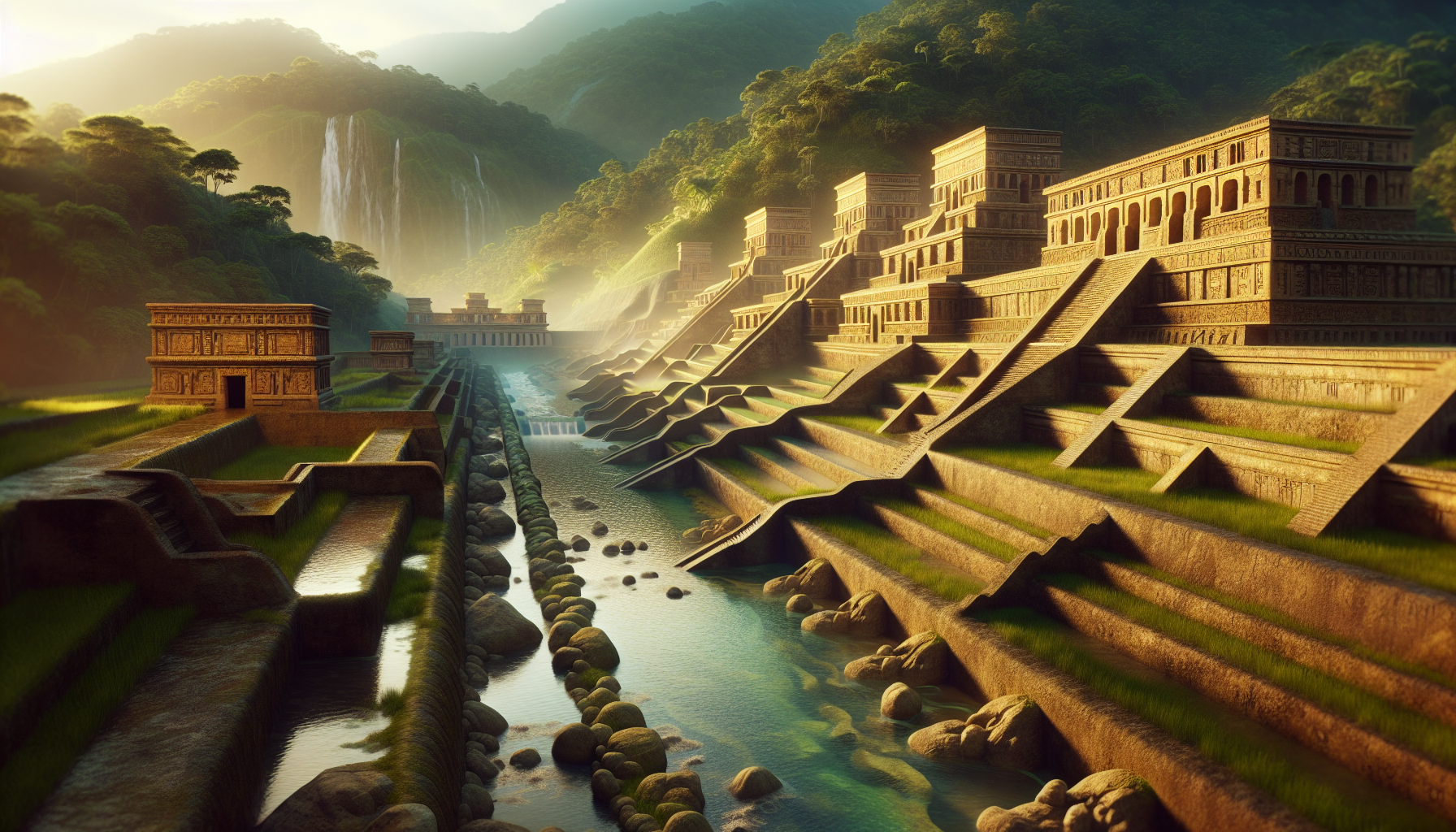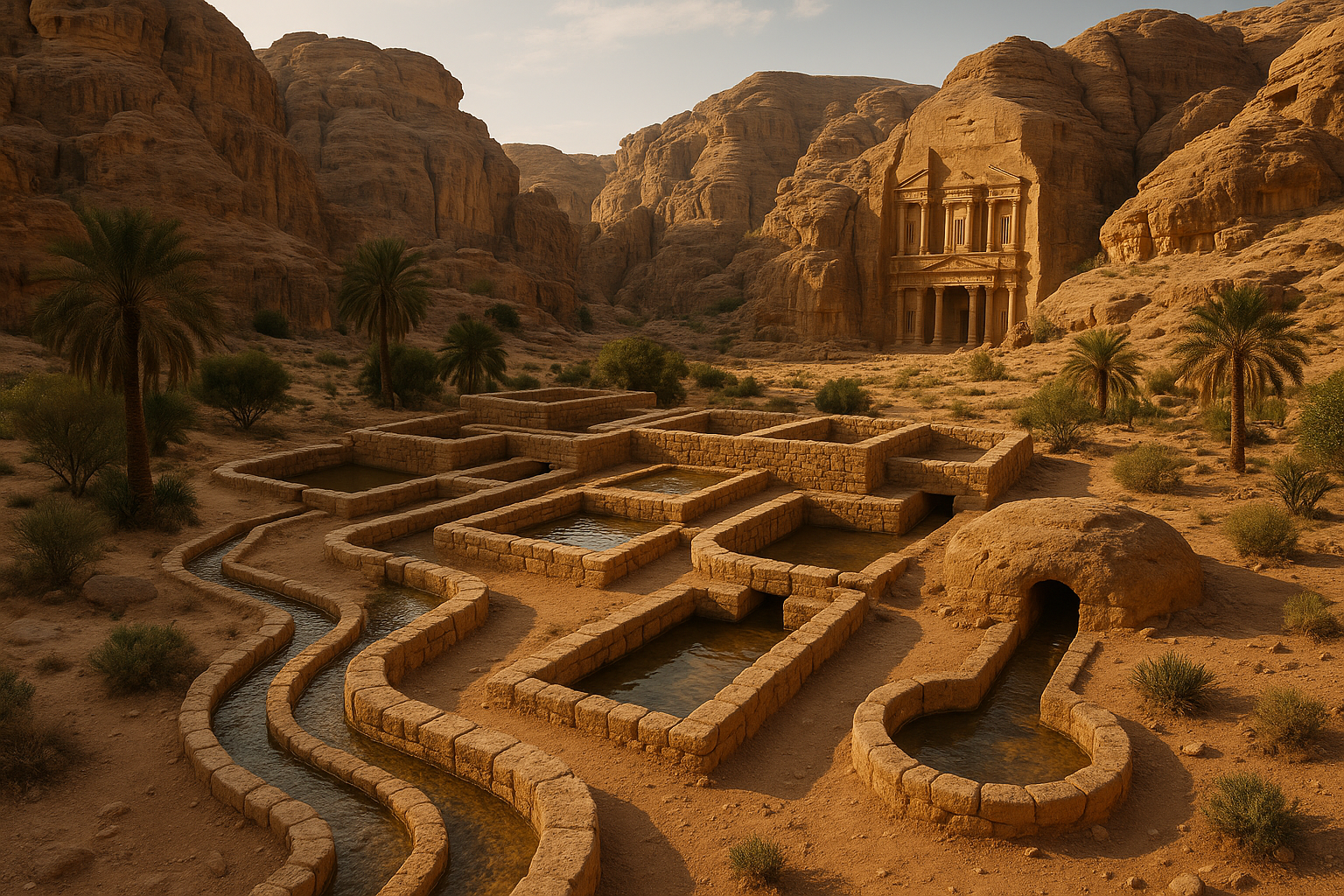In an era where sustainability and environmental consciousness dominate global conversations, it is both enlightening and humbling to look back at the sophisticated practices of ancient civilizations that thrived long before the advent of modern technology. One such intriguing topic is the rainwater catchment strategies of pre-Columbian cities. These civilizations, spread across what is now Latin America, were masters of utilizing natural resources in ways that not only supported their growth but also ensured the preservation of their ecosystems for generations to come. 🌧️ The ingenuity of these early societies provides valuable lessons for contemporary urban planning and environmental management, urging us to reconsider our current approaches to water conservation and sustainability.
Imagine cities that flourished without the modern conveniences of pipelines, pumps, and water treatment plants. Instead, these communities relied on a deep understanding of their local environments, coupled with innovative engineering and architectural techniques, to capture and manage rainwater. From the Maya of the Yucatan Peninsula to the Inca of the Andean highlands, these societies exhibited a remarkable ability to adapt to their diverse and often challenging environments. They developed intricate systems for collecting and storing rainwater, which were integral to their survival and prosperity. As we delve into the rainwater management practices of these ancient cities, we’ll discover a world where sustainability wasn’t just a choice but a necessity for existence.
The strategies employed by these pre-Columbian cities were diverse and highly specialized, reflecting the unique geographical and climatic conditions of each region. For instance, the Maya constructed sophisticated networks of reservoirs, canals, and terraces that not only mitigated the effects of seasonal droughts but also supported agricultural productivity. Meanwhile, the Inca devised terracing and aqueduct systems that harnessed the natural flow of water across their mountainous terrain, ensuring a steady supply for their crops and communities. These practices were not only technically advanced but also deeply rooted in a cultural respect for nature, embodying a holistic approach to living harmoniously with the environment.
In exploring these ancient techniques, we will uncover the remarkable parallels between the environmental challenges faced by pre-Columbian societies and those confronting our world today. Water scarcity, climate variability, and the need for sustainable urban infrastructure are issues that resonate across centuries. As such, there is much to learn from the adaptive strategies and ecological wisdom of these early civilizations. By examining their successes and setbacks, we can glean insights into how to develop more resilient and sustainable urban environments in our current era of rapid urbanization and climate change.
This journey through time and across continents will not only illuminate the innovative spirit of pre-Columbian cities but also challenge us to reimagine our relationship with the natural world. As we uncover the secrets of these ancient rainwater catchment strategies, we will explore how they can inspire contemporary practices that promote sustainability and ecological balance. 🌿 So, join us as we unleash the power of rainwater and delve into the fascinating world of ancient civilizations that mastered the art of sustainable living. The lessons we learn from the past may very well hold the key to securing a sustainable future for our planet.
The Ingenious Water Management of Pre-Columbian Civilizations
The pre-Columbian civilizations of the Americas, including the Maya, Aztec, and Inca, demonstrated remarkable ingenuity in their water management systems. These ancient societies faced unique environmental challenges, from arid deserts to dense rainforests, yet they thrived by developing sophisticated methods for rainwater harvesting. Their sustainable water management strategies are a testament to human innovation and resilience, offering valuable lessons for modern water conservation efforts. 🌿
One of the most striking examples of pre-Columbian water management is found in the ancient Maya civilization. The Maya, who inhabited regions of present-day Mexico, Guatemala, Belize, and Honduras, developed complex systems of reservoirs, canals, and terraced fields to capture and distribute rainwater. These structures allowed them to maintain agriculture and sustain large urban populations even during prolonged dry seasons. The Maya city of Tikal, for instance, featured a network of interconnected reservoirs capable of storing millions of gallons of water. Such sophisticated systems not only provided a reliable water supply but also demonstrated an understanding of hydrological principles that were ahead of their time.
In contrast, the Aztec civilization, located in the Valley of Mexico, faced challenges related to both water scarcity and excess. The Aztecs built their capital, Tenochtitlán, on an island in Lake Texcoco, necessitating advanced water management to support the city’s inhabitants. They constructed an elaborate system of aqueducts and causeways, as well as the famous chinampas—artificial islands used for agriculture. These floating gardens, built on shallow lake beds, effectively expanded arable land and optimized water usage, showcasing the Aztecs’ innovative approach to sustainable agriculture. 🌾
Maya Water Management: The Reservoirs of Tikal
The city of Tikal provides a compelling case study of pre-Columbian water management. Located in the rainforests of present-day Guatemala, Tikal was one of the largest and most influential Maya cities. Despite its lush environment, Tikal experienced seasonal variations in rainfall, with long dry periods posing a significant challenge. To overcome this, the Maya engineered a series of reservoirs to collect and store rainwater during the rainy season, ensuring a steady supply throughout the year.
The reservoirs of Tikal were intricately designed to maximize water capture and storage. They were strategically located near the city’s ceremonial center, with channels and levees directing rainwater into these massive storage units. Some of these reservoirs were lined with plaster to prevent seepage, reflecting an advanced understanding of materials science and engineering. Additionally, the Maya constructed catchment areas to funnel runoff from nearby structures into the reservoirs, effectively utilizing the natural landscape to enhance water collection.
The success of Tikal’s water management system is evident in the city’s ability to sustain a population of tens of thousands, even during prolonged droughts. This achievement highlights the Maya’s deep understanding of their environment and their capacity to develop innovative solutions tailored to their unique challenges. For modern societies facing water scarcity, the lessons from Tikal underscore the importance of sustainable and context-specific water management practices.
The Aztec Aqueducts and Chinampas: Engineering Marvels
The Aztecs, known for their architectural and engineering prowess, developed an ingenious water management system to support their capital, Tenochtitlán. Situated on an island in Lake Texcoco, the city was prone to both flooding and water shortages. To address these issues, the Aztecs constructed a series of aqueducts to transport fresh water from springs on the mainland to the city. These aqueducts were marvels of engineering, featuring elevated channels and siphons to navigate the region’s varied topography.
The aqueducts of Tenochtitlán were crucial for supplying the city’s growing population with fresh water, facilitating urban development, and supporting the flourishing culture of the Aztec empire. However, the Aztecs did not rely solely on aqueducts for their water needs. They also developed the chinampa system, which played a vital role in food production and water management.
Chinampas, often referred to as “floating gardens,” were artificial islands constructed from mud, sediment, and organic material. These fertile plots were built in the shallow waters of Lake Texcoco, providing an efficient means of growing crops in a challenging environment. The chinampas were separated by canals, which not only allowed for easy transportation of goods but also served as water reservoirs, maintaining a stable water table and enhancing soil fertility. This innovative approach to agriculture maximized resource efficiency and contributed to the resilience of the Aztec civilization. 🚤
Lessons from the Aztec Water Management System
The Aztec water management system offers valuable insights for contemporary water conservation efforts. By integrating aqueducts and chinampas, the Aztecs created a multifaceted approach to water management that balanced the needs of urban infrastructure with agricultural productivity. This holistic strategy ensured the sustainability of both their city and their food supply, underscoring the importance of integrated water resource management.
Modern cities can draw inspiration from the Aztec approach by exploring innovative solutions that optimize water use and minimize waste. The use of green infrastructure, such as rain gardens and permeable pavements, mirrors the principles of the chinampa system, enhancing urban resilience to climate change. Additionally, the emphasis on maintaining natural water cycles and supporting biodiversity aligns with contemporary goals of sustainable development.
To delve deeper into the fascinating world of Aztec engineering, watch this video that explores the construction and significance of their water management systems: [How the Aztecs Engineered a City of Islands | It’s History](https://www.youtube.com/watch?v=dXMUhOKjQyw).
Pre-Columbian Innovations in the Inca Empire
The Inca Empire, spanning a vast expanse of the Andes Mountains, faced unique water management challenges due to its diverse geography. From arid coastal deserts to high-altitude plateaus, the Incas developed innovative techniques to harness rainwater and optimize its use. Their ability to adapt to such varied environments showcases their ingenuity and offers valuable lessons for modern water management practices.
One of the most notable Inca innovations was the construction of extensive terrace systems, which allowed them to cultivate crops on steep mountain slopes. These terraces, supported by sophisticated irrigation networks, captured and distributed rainwater efficiently, preventing soil erosion and maximizing agricultural productivity. The use of stone-lined channels and canals facilitated the controlled flow of water, ensuring that even the most challenging terrains could be cultivated successfully.
In addition to terraces, the Incas constructed large cisterns and reservoirs to store water for use during dry periods. These storage facilities, often located near important agricultural sites, were integral to maintaining food security and supporting the empire’s population. The Incas’ ability to manage water resources effectively was a key factor in their ability to sustain a vast and complex civilization.
Exploring Inca Terraces and Water Channels
The Inca terraces are a remarkable example of sustainable land management and water conservation. Built into the rugged Andean landscape, these terraces transformed inhospitable slopes into fertile fields, enabling the Incas to cultivate a diverse array of crops. The terraces were meticulously engineered, with each level designed to capture and distribute water efficiently, reducing runoff and conserving soil moisture.
The water channels that accompanied the terraces were equally impressive. Constructed from precisely fitted stones, these channels directed rainwater from mountain springs to the agricultural terraces below. The Incas understood the importance of maintaining a steady water supply and designed their channels to minimize water loss through evaporation and seepage. This attention to detail ensured that even during dry spells, the terraces remained productive and sustainable.
The success of Inca water management strategies highlights the importance of adapting techniques to suit local environments. By embracing the principles of conservation and resource efficiency, the Incas were able to thrive in some of the most challenging landscapes on Earth. Their legacy serves as a reminder of the power of innovation and the potential for sustainable development in the face of environmental challenges.
Comparative Analysis: Lessons from Pre-Columbian Water Management
The water management strategies of the Maya, Aztec, and Inca civilizations offer a wealth of insights for contemporary efforts to address water scarcity and promote sustainable development. By examining these ancient systems, we can identify key principles that remain relevant today and explore how they can be adapted to meet modern challenges.
| Civilization | Key Water Management Techniques | Lessons for Modern Water Management |
|---|---|---|
| Maya | Reservoirs, Canals, Terraced Fields |
|
| Aztec | Aqueducts, Chinampas, Canals |
|
| Inca | Terraces, Water Channels, Cisterns |
|
The comparative analysis of these pre-Columbian water management systems reveals common themes of sustainability, innovation, and adaptability. By prioritizing the efficient use of resources and tailoring solutions to specific environmental contexts, these ancient civilizations demonstrated a profound understanding of their natural surroundings. In today’s rapidly changing world, these principles remain as relevant as ever, offering a roadmap for developing resilient and sustainable water management practices.
For more insights on how ancient water management techniques can inform modern practices, consider exploring further resources and engaging with community efforts to promote sustainable water use. As we face the challenges of climate change and growing populations, the wisdom of pre-Columbian civilizations provides both inspiration and guidance for building a more sustainable future. 🌎

Conclusion
In this exploration of ancient rainwater management techniques, we’ve traversed the innovative strategies employed by Pre-Columbian cities, shedding light on their sophisticated understanding of sustainable water catchment. These civilizations, often overshadowed by their monumental architectural achievements, showcased an impressive command over their natural resources, particularly in how they harnessed rainwater to sustain large populations and ensure the longevity of their cities.
To recapitulate, we began by examining the ingenious methods of the Maya, whose reservoirs and channel systems were marvels of engineering. Their ability to transform challenging topographies into thriving habitats underscores a profound understanding of ecological balance. These systems were not only functional but intricately woven into the cultural and spiritual fabric of their society, illustrating a holistic approach to environmental stewardship.
Next, we ventured into the Andes, where the Inca civilization demonstrated a mastery of water management through terracing and aqueducts. Their techniques allowed for agricultural expansion and urban development in some of the most inhospitable terrains, showcasing a symbiotic relationship with nature. The Incas’ meticulous planning and reverence for natural resources are lessons that resonate with today’s environmental challenges.
We also explored the innovations of the Aztec Empire, whose floating gardens, or chinampas, were a testament to adaptive ingenuity. These agricultural platforms not only provided sustenance but also contributed to biodiversity, serving as microhabitats for a variety of species. The Aztecs’ ability to optimize limited water resources in a densely populated area reflects a level of sustainability that modern urban centers strive to emulate.
The overarching theme throughout these examples is the harmonious integration of natural resource management with societal needs. Pre-Columbian civilizations were not only able to survive but to thrive in their respective environments by harnessing the power of rainwater. Their achievements offer valuable insights into sustainable living and urban planning, highlighting the potential of ancient wisdom in addressing contemporary environmental issues.
In reinforcing the importance of this topic, it becomes clear that learning from the past is imperative for shaping a sustainable future. The strategies employed by these ancient cultures are not merely historical footnotes; they are blueprints for innovation. As we face growing concerns over climate change and water scarcity, the lessons from Pre-Columbian rainwater management are more relevant than ever.
We must ask ourselves how we can apply these ancient principles to modern challenges. By fostering a deeper connection with our environment and adopting a more integrated approach to resource management, we can create resilient communities capable of withstanding ecological changes. Moreover, these strategies encourage us to rethink our relationship with nature, inspiring a shift from exploitation to coexistence.
In conclusion, the story of rainwater management in Pre-Columbian cities is not just about ancient engineering marvels; it is a narrative of human ingenuity and resilience. By embracing the lessons of these early innovators, we can unlock new possibilities for sustainable development and water conservation.
We invite you, the reader, to reflect on these insights and consider how they might be applied in your own life or community. Whether it’s through rainwater harvesting at home or advocating for sustainable urban planning, every small step contributes to a larger movement towards environmental sustainability.
Feel free to share this article with others who may find inspiration in the past to forge a more sustainable future. Let’s continue the conversation on how ancient wisdom can guide modern solutions. 🌱💧
References:
1. Scarborough, V. L. (2003). “The Flow of Power: Ancient Water Systems and Landscapes”. SAR Press. [Active link: https://sarweb.org]
2. Dunning, N. P., et al. (2012). “Ancient Maya Water Management and the Rise of Classic Maya Civilization”. University of Texas Press. [Active link: https://utexas.edu]
3. Smith, M. E. (2012). “The Aztecs”. Blackwell Publishing. [Active link: https://blackwellpublishing.com]
Further Reading:
– “The Role of Water in Ancient Societies” – [Link: https://journals.uchicago.edu]
– “Sustainable Water Management in History” – [Link: https://cambridge.org]
Let’s tap into the reservoir of knowledge left by our ancestors and flow towards a future where sustainability is at the heart of our existence. 🌍




